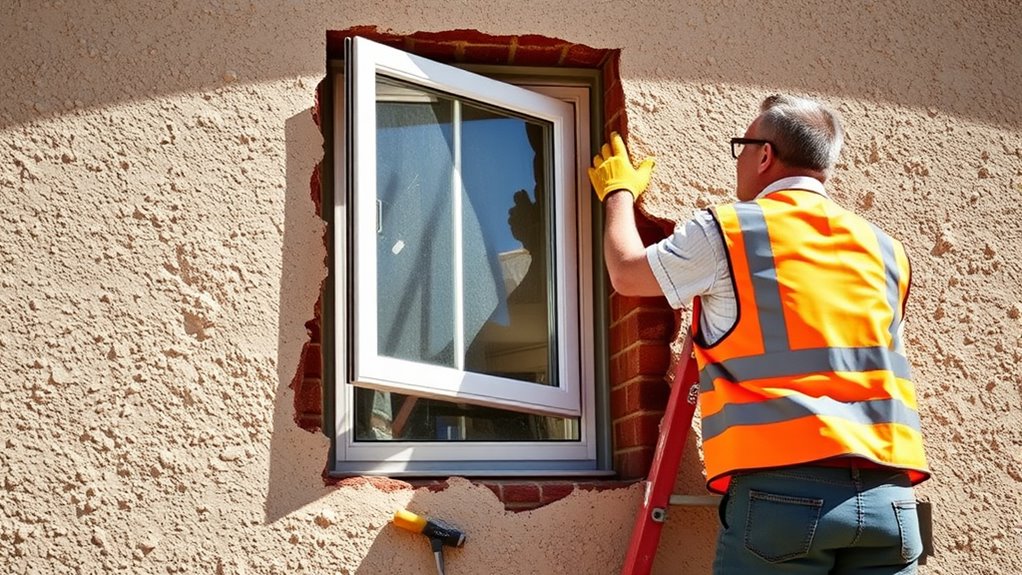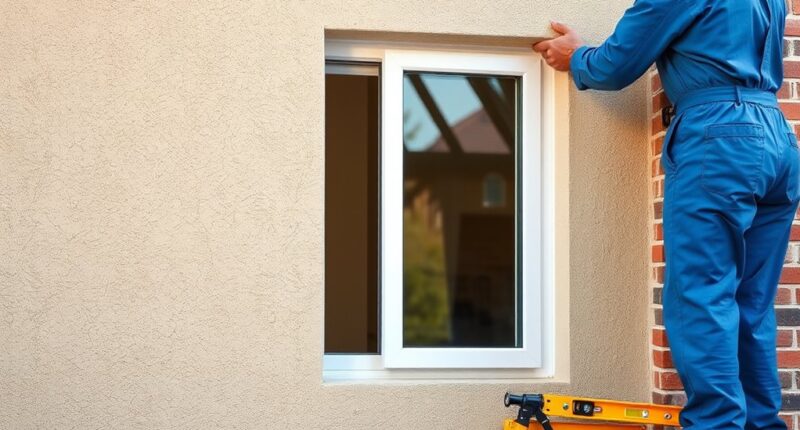When replacing windows in stucco or brick walls, you must carefully plan and execute each step to guarantee a durable, waterproof installation. Start by inspecting and precisely measuring the opening, then carefully remove the old window and surrounding materials without damaging the structure. Properly install flashing, weather barriers, and sealants to prevent water infiltration. Achieve a seamless finish by matching the exterior surface and ensuring long-term durability—there’s more to mastering this process for professional results.
Key Takeaways
- Carefully remove the existing stucco or brick to expose the wall opening without damaging structural elements.
- Accurately measure and prepare the opening, reinforcing framing as needed for a secure fit.
- Install the new window with proper leveling, shimming, and sealing to ensure watertightness.
- Apply flashing and weather barriers to direct water away and prevent leaks around the window.
- Match and finish the exterior surface seamlessly with the existing stucco or brick for a professional appearance.

Replacing windows in stucco or brick walls requires careful planning and precise execution to guarantee a secure fit and maintain the wall’s integrity. You need to approach this task with a detailed understanding of the wall’s structure, materials, and the specific installation techniques that preserve the durability of the exterior finish. The process begins with a thorough inspection of the existing wall and window opening. Measure the dimensions accurately, accounting for any irregularities or settling that might have occurred over time. It’s crucial to create a detailed plan, including the removal method, framing adjustments, and sealing procedures, to ensure a seamless integration of the new window.
Before starting, you should gather all necessary tools and materials, including a reciprocating saw, pry bar, level, shims, masonry drill, flashing, and appropriate sealants. Protect the surrounding area with tarps or plastic sheeting to contain dust and debris. When removing the old window, cut through the stucco or brick carefully, avoiding unnecessary damage to the wall’s structure. For stucco, you might need to score the existing surface to create a clean break, while brick removal requires controlled cutting with a masonry saw. Once the opening is exposed, inspect the framing for damage or rot and reinforce or replace as needed to provide a stable support for the new window.
Fitting the new window involves precise adjustments to ensure it sits plumb, level, and square within the opening. Use shims to achieve proper positioning, and double-check measurements before fastening. Pay close attention to the installation of flashing and weather barriers to prevent water infiltration. Proper flashing installation is critical in brick or stucco walls because it directs water away from the interior and prevents leaks that can cause long-term damage. Seal all joints thoroughly with compatible sealants, especially where the window meets the wall surface, to create a watertight barrier.
Finally, apply the exterior finish to match the existing wall, whether that’s stucco or brick veneer. This step requires skill to blend the new material seamlessly into the existing surface. Keep in mind that proper curing and finishing techniques are indispensable to ensure the longevity and performance of the installation. Throughout the process, maintaining meticulous attention to detail and adhering to best practices will help you achieve a professional, durable, and aesthetically pleasing result that preserves the structural integrity of your wall while providing a secure, energy-efficient window. Additionally, understanding waterproofing techniques is essential in brick or stucco wall installations to prevent moisture intrusion and damage over time.
Frequently Asked Questions
How Do I Prevent Water Damage During Window Replacement?
To prevent water damage during window replacement, make certain you properly seal the opening with a high-quality, weather-resistant flashing. You should remove any damaged or loose caulking, then install a continuous, overlapping flashing strip around the perimeter. Apply a premium, flexible sealant to all joints and edges. Finally, double-check that the window is correctly aligned and securely fastened, creating a tight barrier that prevents water infiltration and protects your wall structure.
What Tools Are Essential for Installing Windows in Brick Walls?
You’ll need a masonry drill, cold chisel, hammer, level, tape measure, and utility knife. Studies show that proper tools reduce installation time by up to 30%, ensuring precision and structural integrity. Use a rotary hammer with masonry bits for drilling into brick, and a cold chisel for removing mortar or creating clean openings. A level guarantees proper alignment, while a utility knife helps seal and trim for a professional finish.
How Long Does a Typical Window Replacement Project Take?
A typical window replacement project takes about one to three days, depending on the complexity of the wall and the window size. You’ll start by removing the old window, preparing the opening, and installing the new unit, ensuring proper sealing and insulation. If the wall’s material or condition is challenging, expect additional time for repairs or adjustments. Planning carefully and working efficiently can help you complete the project within this timeframe.
Are There Energy-Efficient Window Options Suitable for Stucco?
Did you know that energy-efficient windows can reduce your home’s heat loss by up to 40%? You’ll find several options suitable for stucco, including double or triple-pane windows with low-emissivity coatings and gas fills like Argon or Krypton. These features improve insulation and lower energy bills. As an experienced professional, I recommend consulting with a specialist to select the best window type tailored to your climate and stucco installation needs.
Can I Replace Windows Myself, or Should I Hire a Professional?
You can replace windows yourself if you have carpentry skills, proper tools, and experience working with stucco or brick walls. However, because these materials are complex and require precise sealing to prevent leaks and damage, hiring a professional is often the best choice. Professionals ensure proper installation, insulation, and weatherproofing, saving you time and avoiding costly mistakes. If unsure, consult a specialist to guarantee a safe, energy-efficient, and durable replacement.
Conclusion
Replacing windows in stucco or brick walls requires careful planning and precise execution. By following proper techniques and respecting the integrity of your walls, you guarantee a durable, energy-efficient installation. Remember, “A stitch in time saves nine”—addressing issues early prevents costly repairs later. With patience and attention to detail, you’ll achieve professional results that enhance your home’s comfort and curb appeal, giving you peace of mind knowing your investment is well protected.









